Cranioplasty for Large-Sized Calvarial Defects in the Pediatric Population: A Review
Abstract
Autologous Reconstruction
Bone Flap Storage Methods
Timing of Reconstruction
Alloplastic Reconstruction
Acrylics
Ceramics
Titanium
Plastics
Site of Implant
On the Horizon
Our Experience
Conclusion
References
- Grant, G.A.; Jolley, M.; Ellenbogen, R.G.; Roberts, T.S.; Gruss, J.R.; Loeser, J.D. Failure of autologous bone-assisted cranioplasty following decompressive craniectomy in children and adolescents. J Neurosurg 2004, 100(2, Suppl Pediatrics), 163–168. [Google Scholar] [CrossRef]
- Bowers, C.A.; Riva-Cambrin, J.; Hertzler, D.A., II; Walker, M.L. Risk factors and rates of bone flap resorption in pediatric patients after decompressive craniectomy for traumatic brain injury. J Neurosurg Pediatr 2013, 11(5), 526–532. [Google Scholar] [CrossRef] [PubMed]
- Yadla, S.; Campbell, P.G.; Chitale, R.; Maltenfort, M.G.; Jabbour, P.; Sharan, A.D. Effect of early surgery, material, and method of flap preservation on cranioplasty infections: a systematic review. Neurosurgery 2011, 68(4), 1124–1129, discussion 1130. [Google Scholar] [CrossRef]
- Baldo, S.; Tacconi, L. Effectiveness and safety of subcutaneous abdominal preservation of autologous bone flap after decompressive craniectomy: a prospective pilot study. World Neurosurg 2010, 73(5), 552–556. [Google Scholar] [CrossRef]
- Oppenheimer, A.J.; Mesa, J.; Buchman, S.R. Current and emerging basic science concepts in bone biology: implications in craniofacial surgery. J Craniofac Surg 2012, 23(1), 30–36. [Google Scholar] [CrossRef] [PubMed]
- Matsuno, A.; Tanaka, H.; Iwamuro, H.; et al. Analyses of the factors influencing bone graft infection after delayed cranioplasty. Acta Neurochir (Wien) 2006, 148(5), 535–540, discussion 540. [Google Scholar] [CrossRef] [PubMed]
- Osawa, M.; Hara, H.; Ichinose, Y.; Koyama, T.; Kobayashi, S.; Sugita, Y. Cranioplasty with a frozen and autoclaved bone flap. Acta Neurochir (Wien) 1990, 102(1-2), 38–41. [Google Scholar] [CrossRef]
- Morina, A.; Kelmendi, F.; Morina, Q.; et al. Cranioplasty with subcutaneously preserved autologous bone grafts in abdominal wallExperience with 75 cases in a post-war country Kosova. Surg Neurol Int 2011, 2, 72. [Google Scholar] [CrossRef]
- Inamasu, J.; Kuramae, T.; Nakatsukasa, M. Does difference in the storage method of bone flaps after decompressive craniectomy affect the incidence of surgical site infection after cranioplasty? Comparison between subcutaneous pocket and cryopreservation. J Trauma 2010, 68(1), 183–187, discussion 187. [Google Scholar] [CrossRef]
- Yap, C.; Macarthur, D.C.; Hope, D.T. ’Mind the gap’: resorption of a bone flap stored subcutaneously for 6 months. Br J Neurosurg 2002, 16(5), 523–524. [Google Scholar] [CrossRef]
- Bhaskar, I.P.; Inglis, T.J.; Lee, G.Y. Clinical, radiological, and microbiological profile of patients with autogenous cranioplasty infections. World Neurosurg 2014, 82(3–4), e531–e534. [Google Scholar] [CrossRef]
- Huang, Y.H.; Yang, T.M.; Lee, T.C.; Chen, W.F.; Yang, K.Y. Acute autologous bone flap infection after cranioplasty for postinjury decompressive craniectomy. Injury 2013, 44(1), 44–47. [Google Scholar] [CrossRef] [PubMed]
- Piedra, M.P.; Thompson, E.M.; Selden, N.R.; Ragel, B.T.; Guillaume, D.J. Optimal timing of autologous cranioplasty after decompressive craniectomy in children. J Neurosurg Pediatr 2012, 10(4), 268–272. [Google Scholar] [CrossRef] [PubMed]
- Schuss, P.; Vatter, H.; Marquardt, G.; et al. Cranioplasty after decompressive craniectomy: the effect of timing on postoperative complications. J Neurotrauma 2012, 29(6), 1090–1095. [Google Scholar] [CrossRef]
- Sweeny, L.; Eby, B.; Magnuson, J.S.; Carroll, W.R.; Rosenthal, E.L. Reconstruction of scalp defects with the radial forearm free flap. Head Neck Oncol 2012, 4, 21. [Google Scholar] [CrossRef]
- Jia-Ao, Y.; Hong-Jing, L.; Zheng-Hua, J.; Kai, S.; Zhen-Hai, N. Reconstruction of a large pediatric scalp defect with skull exposure by a free anterolateral thigh flap. Plast Reconstr Surg 2012, 129(1), 178e–180e. [Google Scholar] [CrossRef]
- Serletti, J.M.; Schingo VAJr Deuber, M.A.; Carras, A.J.; Herrera, H.R.; Reale, V.F. Free tissue transfer in pediatric patients. Ann Plast Surg 1996, 36(6), 561–568. [Google Scholar] [CrossRef] [PubMed]
- Uusitalo, M.; Ibarra, M.; Fulton, L.; et al. Reconstruction with rectus abdominis myocutaneous free flap after orbital exenteration in children. Arch Ophthalmol 2001, 119(11), 1705–1709. [Google Scholar] [CrossRef]
- Ozkan, O.; Coskunfirat, O.K.; Ozgentas, H.E.; Derin, A. Rationale for reconstruction of large scalp defects using the anterolateral thigh flap: structural and aesthetic outcomes. J Reconstr Microsurg 2005, 21(8), 539–545. [Google Scholar] [CrossRef]
- Iida, T.; Mihara, M.; Yoshimatsu, H.; et al. Reconstruction of an extensive anterior skull base defect using a muscle-sparing rectus abdominis myocutaneous flap in a 1-year-old infant. Microsurgery 2012, 32(8), 622–626. [Google Scholar] [CrossRef]
- Yu, J.A.; Lin, H.J.; Jin, Z.H.; Shi, K.; Niu, Z.H.; Zhao, J.C. Free anterolateral thigh flap for coverage of scalp large defects in pediatric burn population. J Burn Care Res 2012, 33(4), e180–e185. [Google Scholar] [CrossRef] [PubMed]
- Rogers, G.F.; Greene, A.K. Autogenous bone graft: basic science and clinical implications. J Craniofac Surg 2012, 23(1), 323–327. [Google Scholar] [CrossRef]
- Rogers, G.F.; Greene, A.K.; Mulliken, J.B.; Proctor, M.R.; Ridgway, E.B. Exchange cranioplasty using autologous calvarial particulate bone graft effectively repairs large cranial defects. Plast Reconstr Surg 2011, 127(4), 1631–1642. [Google Scholar] [CrossRef]
- Greene, A.K.; Mulliken, J.B.; Proctor, M.R.; Rogers, G.F. Pediatric cranioplasty using particulate calvarial bone graft. Plast Reconstr Surg 2008, 122(2), 563–571. [Google Scholar] [CrossRef] [PubMed]
- Chao, M.T.; Jiang, S.; Smith, D.; et al. Demineralized bone matrix and resorbable mesh bilaminate cranioplasty: a novel method for reconstruction of large-scale defects in the pediatric calvaria. Plast Reconstr Surg 2009, 123(3), 976–982. [Google Scholar] [CrossRef]
- Beederman, M.; Alkureishi, L.W.; Lam, S.; Warnke, P.; Reid, R.R. Exchange hybrid cranioplasty using particulate bone graft and demineralized bone matrix: the best of both worlds. J Craniofac Surg 2014, 25(2), 451–454. [Google Scholar] [CrossRef] [PubMed]
- Jaskolka, M.S.; Olavarria, G. Reconstruction of skull defects. Atlas Oral Maxillofac Surg Clin North Am 2010, 18(2), 139–149. [Google Scholar] [CrossRef]
- Agrawal, A.; Garg, L.N. Split calvarial bone graft for the reconstruction of skull defects. J Surg Tech Case Rep 2011, 3(1), 13–16. [Google Scholar] [CrossRef]
- Inoue, A.; Satoh, S.; Sekiguchi, K.; et al. Cranioplasty with splitthickness calvarial bone. Neurol Med Chir (Tokyo) 1995, 35(11), 804–807. [Google Scholar] [CrossRef]
- Vercler, C.J.; Sugg, K.B.; Buchman, S.R. Split cranial bone grafting in children younger than 3 years old: debunking a surgical myth. Plast Reconstr Surg 2014, 133(6), 822e–827e. [Google Scholar] [CrossRef]
- Lee, J.C.; Kleiber, G.M.; Pelletier, A.T.; Reid, R.R.; Gottlieb, L.J. Autologous immediate cranioplasty with vascularized bone in high-risk composite cranial defects. Plast Reconstr Surg 2013, 132(4), 967–975. [Google Scholar] [CrossRef]
- Smith, D.M.; Afifi, A.M.; Cooper, G.M.; Mooney, M.P.; Marra, K.G.; Losee, J.E. BMP-2-based repair of large-scale calvarial defects in an experimental model: regenerative surgery in cranioplasty. J Craniofac Surg 2008, 19(5), 1315–1322. [Google Scholar] [CrossRef] [PubMed]
- Smith, D.M.; Cooper, G.M.; Afifi, A.M.; et al. Regenerative surgery in cranioplasty revisited: the role of adipose-derived stem cells and BMP-2. Plast Reconstr Surg 2011, 128(5), 1053–1060. [Google Scholar] [CrossRef]
- Yonamine, Y.; Matsuyama, T.; Sonomura, T.; et al. Effectable application of vascular endothelial growth factor to critical sized rat calvaria defects. Oral Surg Oral Med Oral Pathol Oral Radiol Endod 2010, 109(2), 225–231. [Google Scholar] [CrossRef] [PubMed]
- Shah, M.M.; Smyth, M.D.; Woo, A.S. Adverse facial edema associated with off-label use of recombinant human bone morphogenetic protein-2 in cranial reconstruction for craniosynostosis. Case report. J Neurosurg Pediatr 2008, 1(3), 255–257. [Google Scholar] [CrossRef] [PubMed]
- Vignes, J.R.; Jeelani Nu Dautheribes, M.; San-Galli, F.; Liguoro, D. Cranioplasty for repair of a large bone defect in a growing skull fracture in children. J Craniomaxillofac Surg 2007, 35(3), 185–188. [Google Scholar] [CrossRef]
- Lin, A.Y.; Kinsella, C.R., Jr.; Rottgers, S.A.; et al. Custom porous polyethylene implants for large-scale pediatric skull reconstruction: early outcomes. J Craniofac Surg 2012, 23(1), 67–70. [Google Scholar] [CrossRef]
- Lee, S.C.; Wu, C.T.; Lee, S.T.; Chen, P.J. Cranioplasty using polymethyl methacrylate prostheses. J Clin Neurosci 2009, 16(1), 56–63. [Google Scholar] [CrossRef]
- Marchac, D.; Greensmith, A. Long-term experience with methylmethacrylate cranioplasty in craniofacial surgery. J Plast Reconstr Aesthet Surg 2008, 61(7), 744–752, discussion 753. [Google Scholar] [CrossRef]
- Moreira-Gonzalez, A.; Jackson, I.T.; Miyawaki, T.; Barakat, K.; DiNick, V. Clinical outcome in cranioplasty: critical review in long-term follow-up. J Craniofac Surg 2003, 14(2), 144–153. [Google Scholar] [CrossRef]
- Jaberi, J.; Gambrell, K.; Tiwana, P.; Madden, C.; Finn, R. Long-term clinical outcome analysis of poly-methyl-methacrylate cranioplasty for large skull defects. J Oral Maxillofac Surg 2013, 71(2), e81–e88. [Google Scholar] [CrossRef]
- Golz, T.; Graham, C.R.; Busch, L.C.; Wulf, J.; Winder, R.J. Temperature elevation during simulated polymethylmethacrylate (PMMA) cranioplasty in a cadaver model. J Clin Neurosci 2010, 17(5), 617–622. [Google Scholar] [CrossRef]
- Josan, V.A.; Sgouros, S.; Walsh, A.R.; Dover, M.S.; Nishikawa, H.; Hockley, A.D. Cranioplasty in children. Childs Nerv Syst 2005, 21(3), 200–204. [Google Scholar] [CrossRef] [PubMed]
- Baker, S.B.; Weinzweig, J.; Kirschner, R.E.; Bartlett, S.P. Applications of a new carbonated calcium phosphate bone cement: early experience in pediatric and adult craniofacial reconstruction. Plast Reconstr Surg 2002, 109(6), 1789–1796. [Google Scholar] [CrossRef]
- Stefini, R.; Esposito, G.; Zanotti, B.; Iaccarino, C.; Fontanella, M.M.; Servadei, F. Use of “custom made” porous hydroxyapatite implants for cranioplasty: postoperative analysis of complications in 1549 patients. Surg Neurol Int 2013, 4, 12. [Google Scholar] [CrossRef]
- Kirschner, R.E.; Karmacharya, J.; Ong, G.; et al. Repair of the immature craniofacial skeleton with a calcium phosphate cement: quantitative assessment of craniofacial growth. Ann Plast Surg 2002, 49(1), 33–38, discussion 38. [Google Scholar] [CrossRef] [PubMed]
- Smartt, J.M., Jr.; Karmacharya, J.; Gannon, F.H.; et al. Repair of the immature and mature craniofacial skeleton with a carbonated calcium phosphate cement: assessment of biocompatibility, osteoconductivity, and remodeling capacity. Plast Reconstr Surg 2005, 115(6), 1642–1650. [Google Scholar] [CrossRef] [PubMed]
- Losee, J.E.; Karmacharya, J.; Gannon, F.H.; et al. Reconstruction of the immature craniofacial skeleton with a carbonated calcium phosphate bone cement: interaction with bioresorbable mesh. J Craniofac Surg 2003, 14(1), 117–124. [Google Scholar] [CrossRef]
- Singh, K.A.; Burstein, F.D.; Williams, J.K. Use of hydroxyapatite cement in pediatric craniofacial reconstructive surgery: strategies for avoiding complications. J Craniofac Surg 2010, 21(4), 1130–1135. [Google Scholar] [CrossRef]
- Wong, R.K.; Gandolfi, B.M.; St-Hilaire, H.; Wise, M.W.; Moses, M. Complications of hydroxyapatite bone cement in secondary pediatric craniofacial reconstruction. J Craniofac Surg 2011, 22(1), 247–251. [Google Scholar] [CrossRef]
- Gilardino, M.S.; Cabiling, D.S.; Bartlett, S.P. Long-term follow-up experience with carbonated calcium phosphate cement (Norian) for cranioplasty in children and adults. Plast Reconstr Surg 2009, 123(3), 983–994. [Google Scholar] [CrossRef] [PubMed]
- Wiggins, A.; Austerberry, R.; Morrison, D.; Ho, K.M.; Honeybul, S. Cranioplasty with custom-made titanium plates—14 years experience. Neurosurgery 2013, 72(2), 248–256, discussion 256. [Google Scholar] [CrossRef] [PubMed]
- Eufinger, H.; et al. Management of cranial and craniofacial bone defects with prefabricated individual titanium implants: followup and evaluation of 166 patients with 169 titanium implants from 1994–2000. Int J CARS 2006, 1(4), 197–203. [Google Scholar] [CrossRef]
- Cabraja, M.; Klein, M.; Lehmann, T.N. Long-term results following titanium cranioplasty of large skull defects. Neurosurg Focus 2009, 26(6), E10. [Google Scholar] [CrossRef] [PubMed]
- Lethaus, B.; Safi, Y.; ter Laak-Poort, M.; et al. Cranioplasty with customized titanium and PEEK implants in a mechanical stress model. J Neurotrauma 2012, 29(6), 1077–1083. [Google Scholar] [CrossRef]
- Maas, C.S.; Merwin, G.E.; Wilson, J.; Frey, M.D.; Maves, M.D. Comparison of biomaterials for facial bone augmentation. Arch Otolaryngol Head Neck Surg 1990, 116(5), 551–556. [Google Scholar] [CrossRef]
- Carboni, A.; et al. Long-term follow-up of 105 porous polyethylene implants used to correct facial deformity. Eur J Plast Surg 2002, 25(6), 310–314. [Google Scholar]
- Cestero, H.J., Jr.; Salyer, K.E.; Toranto, I.R. Bone growth into porous carbon, polyethylene, and polypropylene prostheses. J Biomed Mater Res 1975, 9(4), 1–7. [Google Scholar] [CrossRef]
- Tark, W.H.; Yoon, I.S.; Rah, D.K.; Park, B.Y.; Kim, Y.O. Osteoconductivity of porous polyethylene in human skull. J Craniofac Surg 2012, 23(1), 78–80. [Google Scholar] [CrossRef]
- Wang, J.C.; Wei, L.; Xu, J.; Liu, J.F.; Gui, L. Clinical outcome of cranioplasty with high-density porous polyethylene. J Craniofac Surg 2012, 23(5), 1404–1406. [Google Scholar] [CrossRef]
- Gordon, C.R.; Fisher, M.; Liauw, J.; et al. Multidisciplinary approach for improved outcomes in secondary cranial reconstruction: introducing the pericranial-onlay cranioplasty technique. Neurosurgery 2014, 10(Suppl 2), 179–189, discussion 189–190. [Google Scholar] [CrossRef] [PubMed]
- Oei, J.D.; Zhao, W.W.; Chu, L.; et al. Antimicrobial acrylic materials with in situ generated silver nanoparticles. J Biomed Mater Res B Appl Biomater 2012, 100(2), 409–415. [Google Scholar] [CrossRef] [PubMed]
- Springer, I.N.; Açil, Y.; Kuchenbecker, S.; et al. Bone graft versus BMP-7 in a critical size defect—cranioplasty in a growing infant model. Bone 2005, 37(4), 563–569. [Google Scholar] [CrossRef] [PubMed]
- Cheng, H.; Jiang, W.; Phillips, F.M.; et al. Osteogenic activity of the fourteen types of human bone morphogenetic proteins (BMPs). J Bone Joint Surg Am 2003, 85-A(8), 1544–1552. [Google Scholar] [CrossRef]
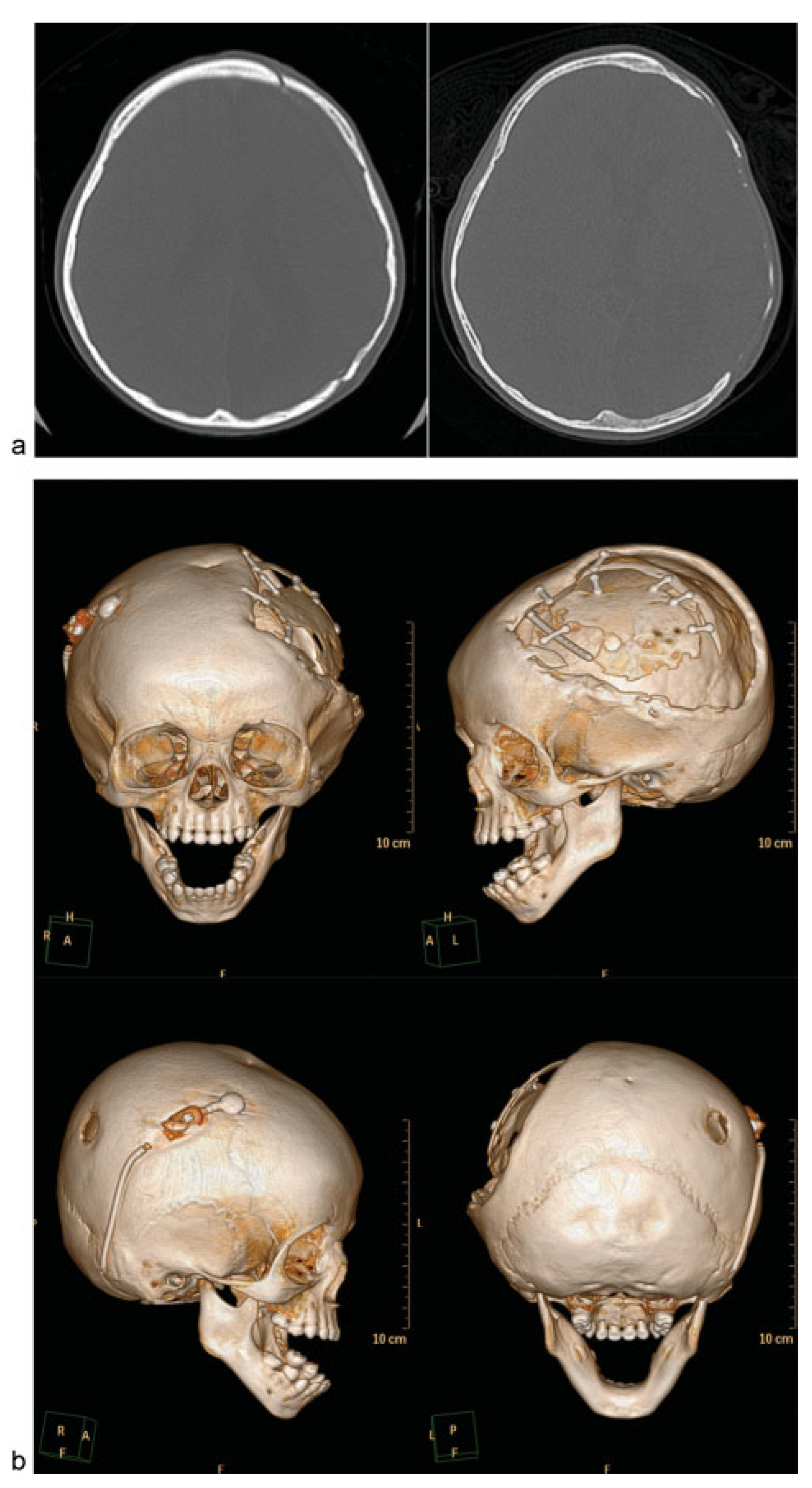
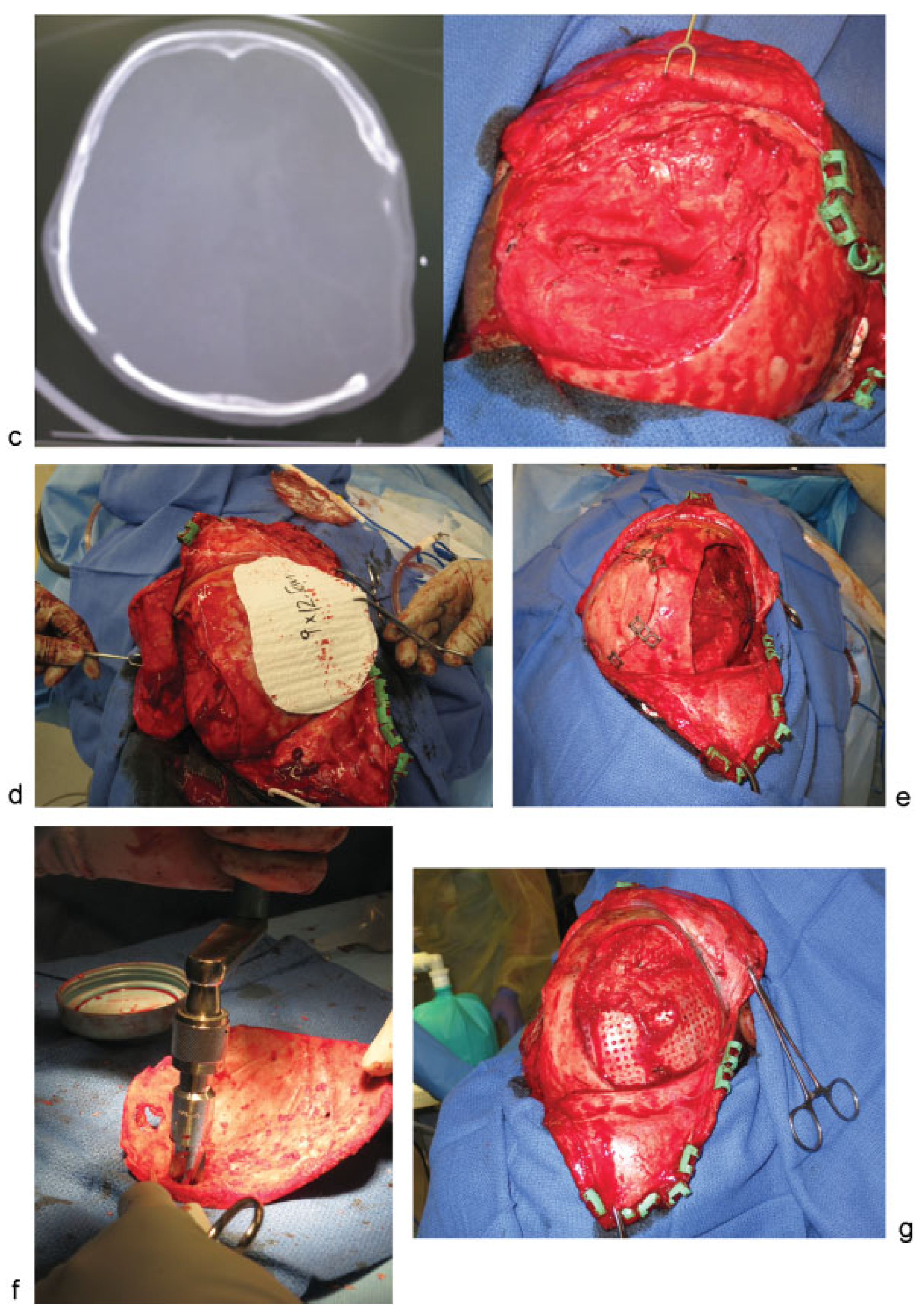
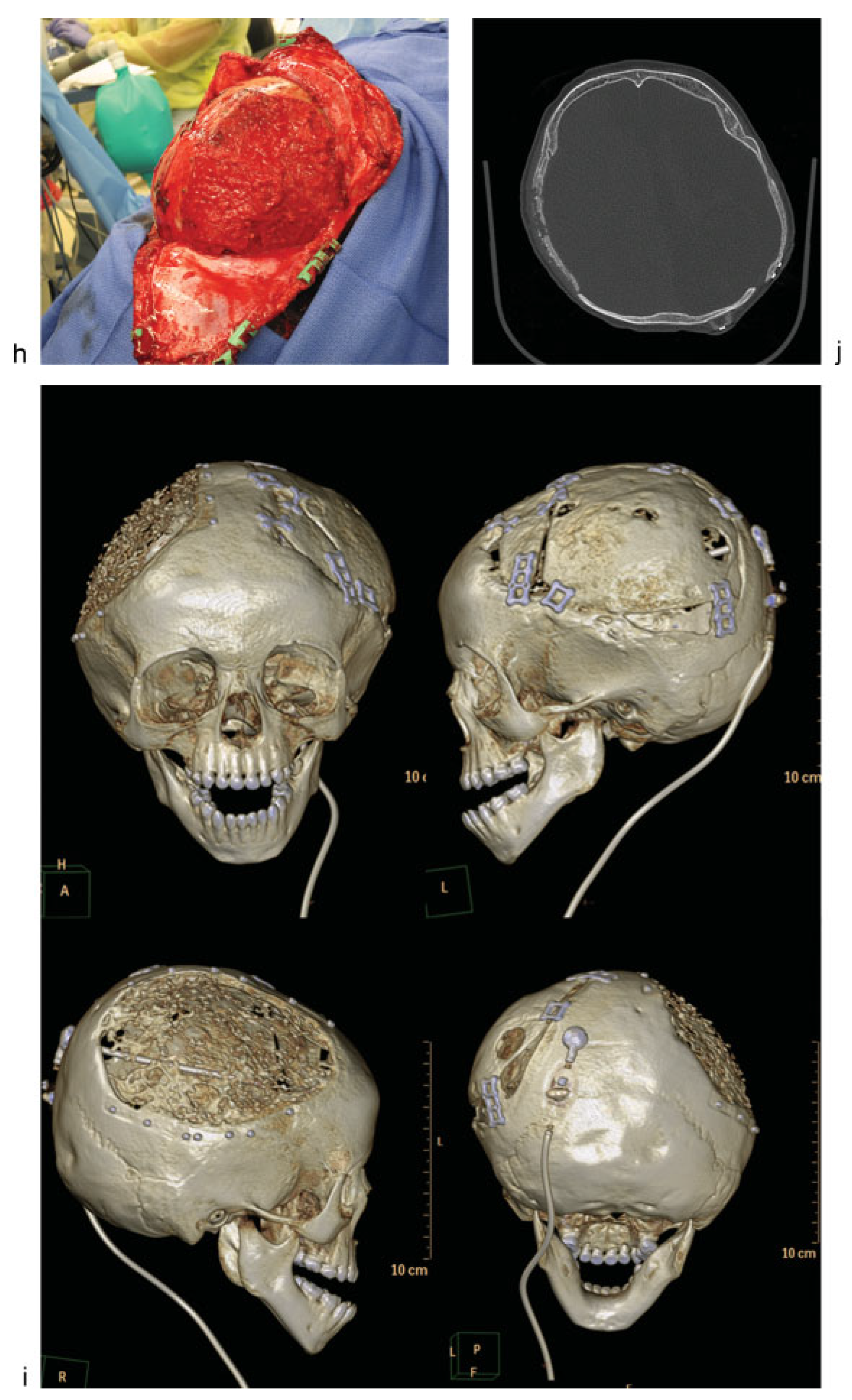
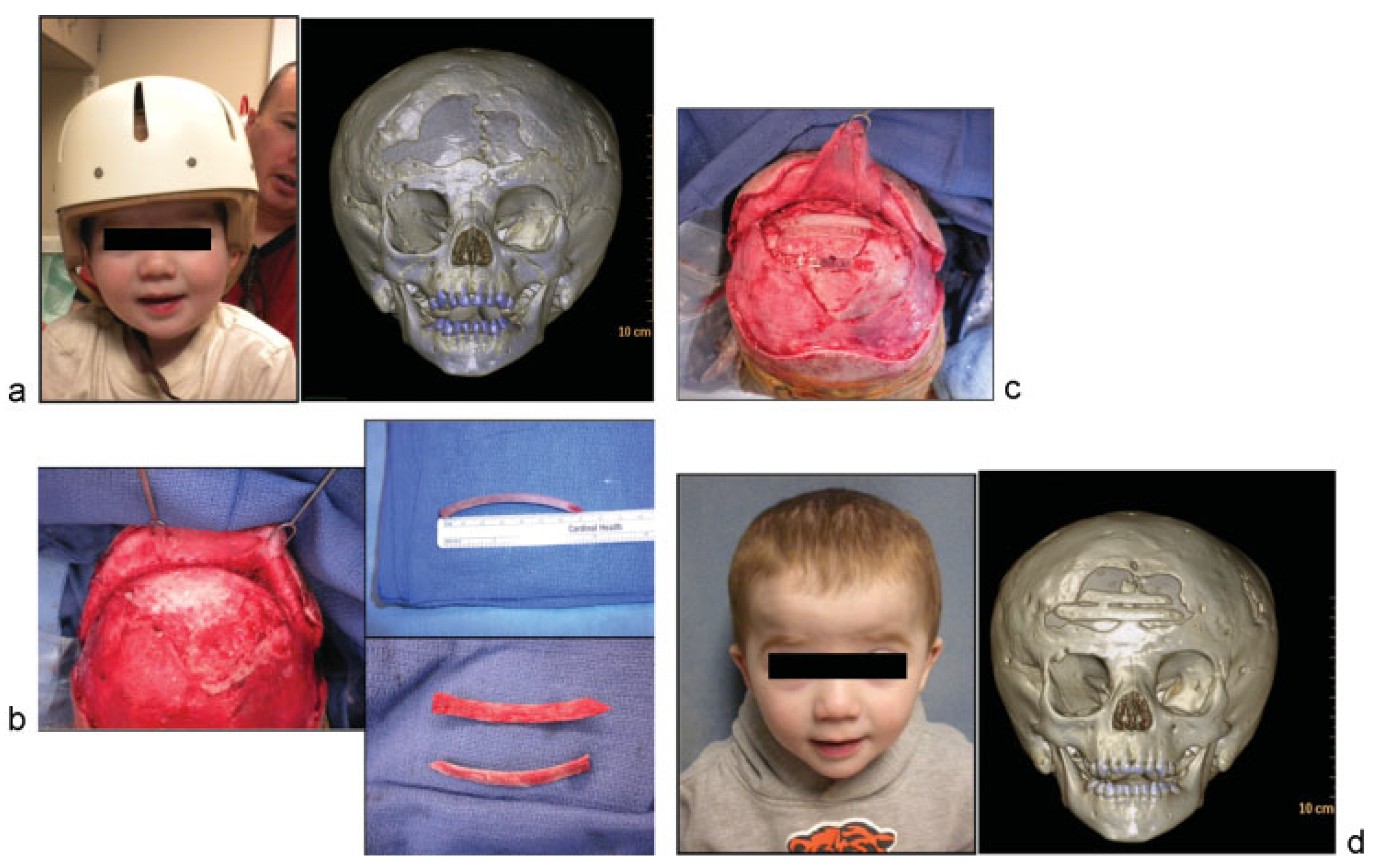
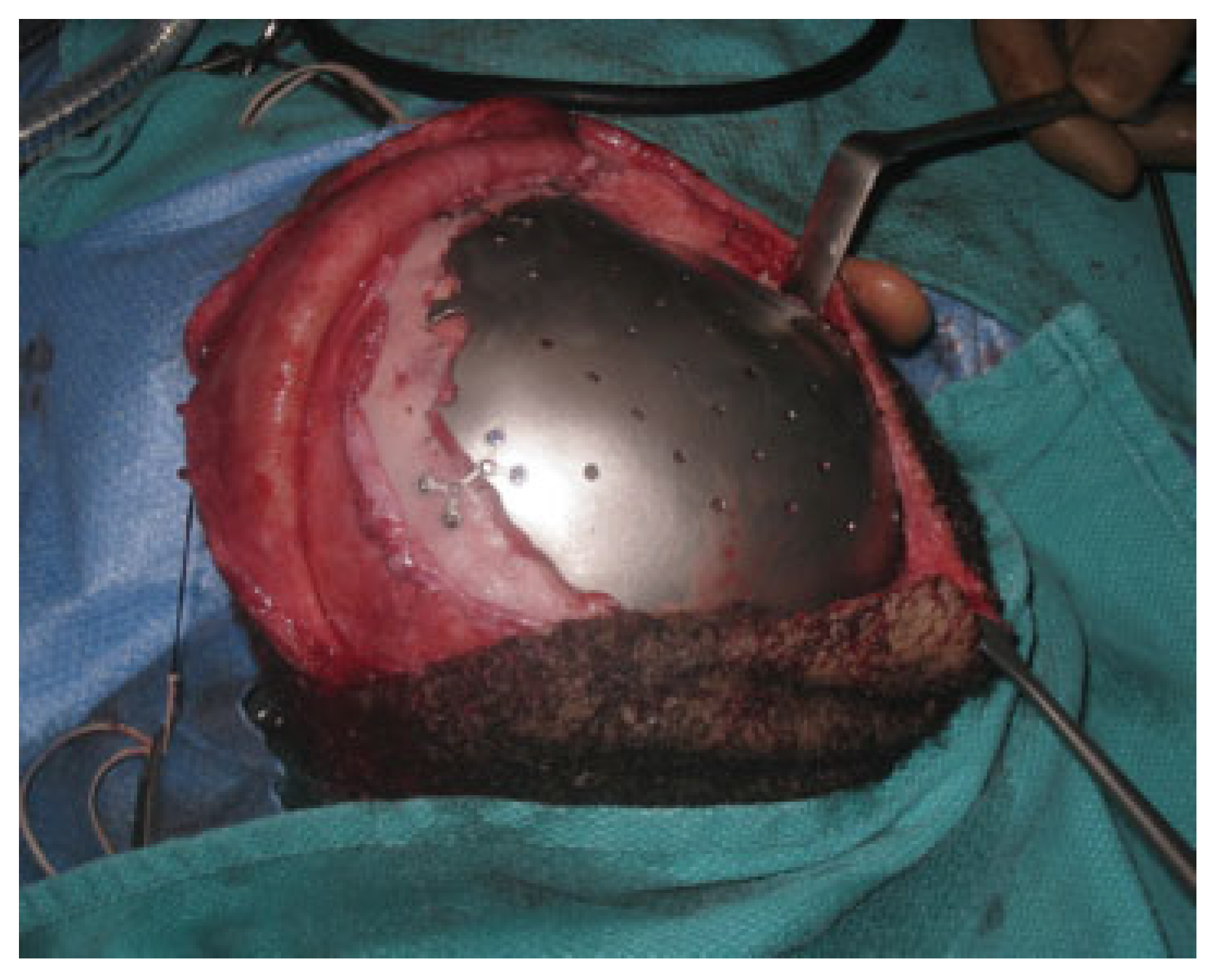
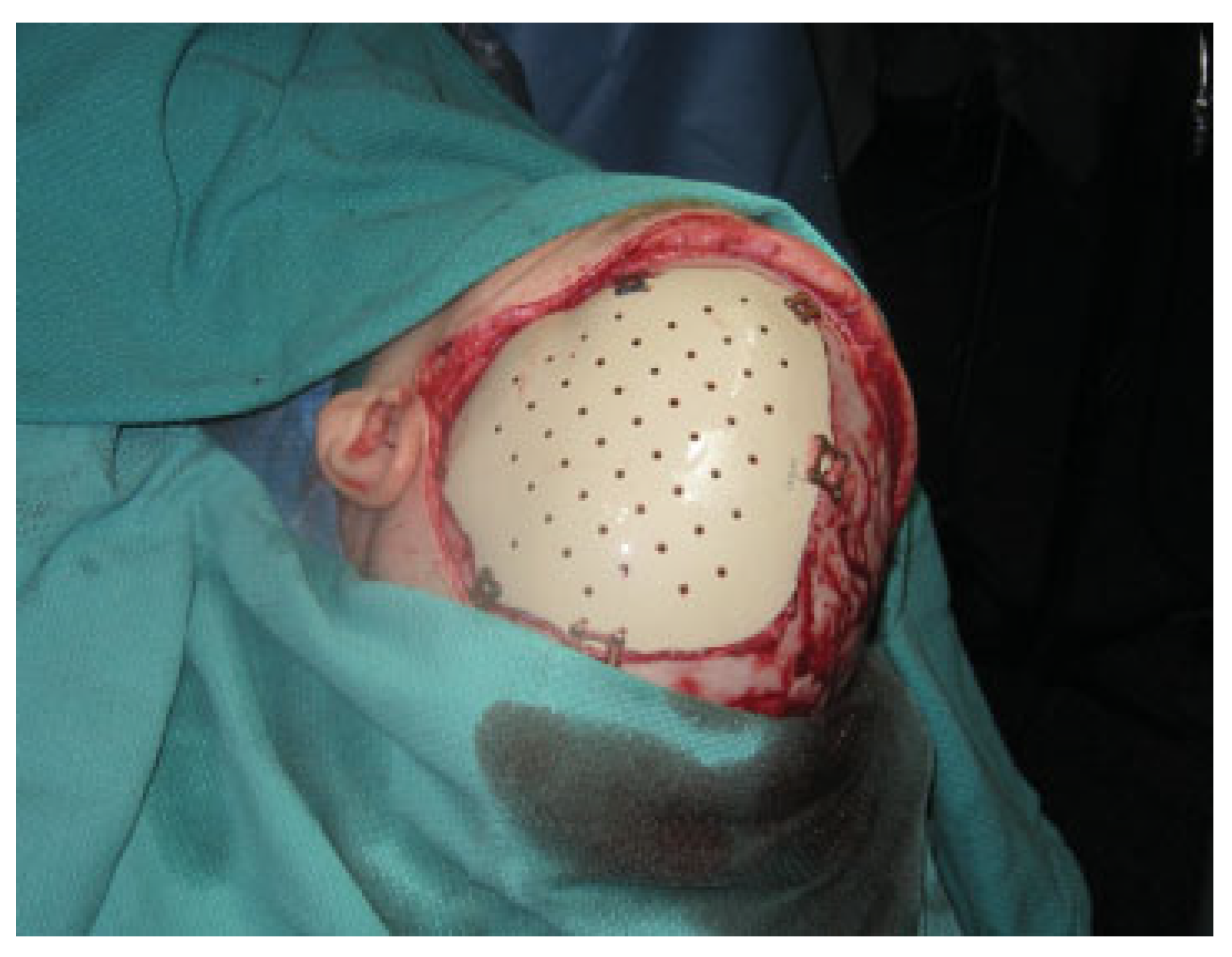
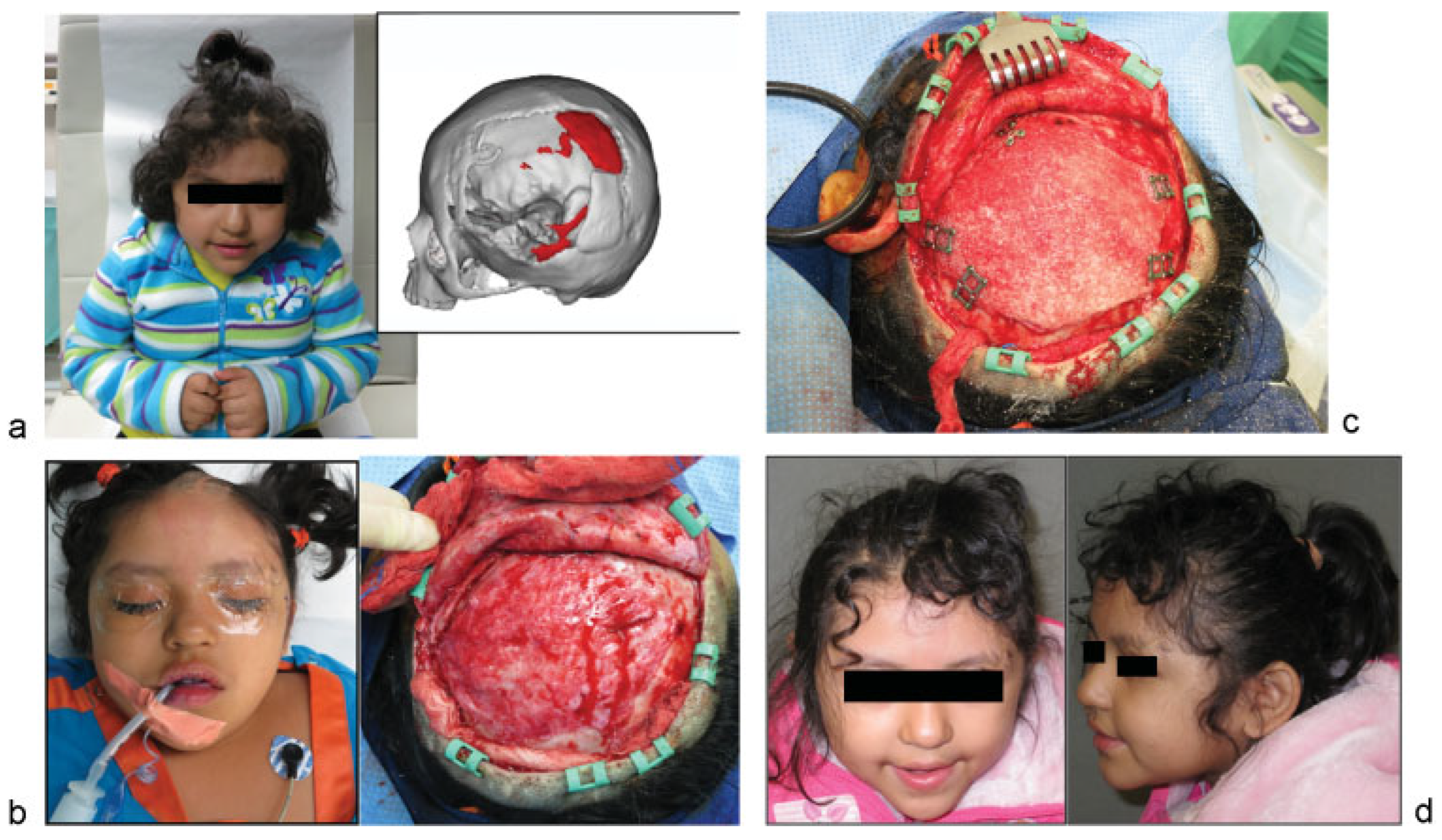

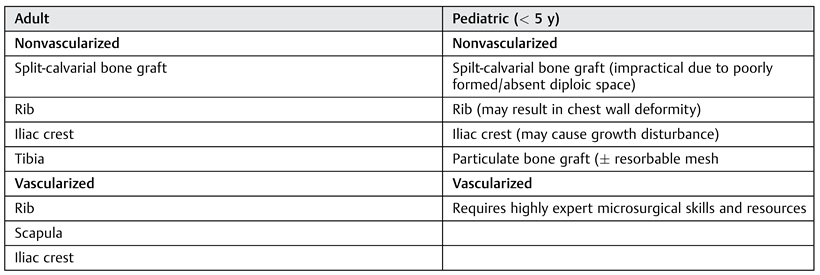
© 2014 by the author. The Author(s) 2014.
Share and Cite
Lam, S.; Kuether, J.; Fong, A.; Reid, R. Cranioplasty for Large-Sized Calvarial Defects in the Pediatric Population: A Review. Craniomaxillofac. Trauma Reconstr. 2015, 8, 159-170. https://doi.org/10.1055/s-0034-1395880
Lam S, Kuether J, Fong A, Reid R. Cranioplasty for Large-Sized Calvarial Defects in the Pediatric Population: A Review. Craniomaxillofacial Trauma & Reconstruction. 2015; 8(2):159-170. https://doi.org/10.1055/s-0034-1395880
Chicago/Turabian StyleLam, Sandi, Justin Kuether, Abigail Fong, and Russell Reid. 2015. "Cranioplasty for Large-Sized Calvarial Defects in the Pediatric Population: A Review" Craniomaxillofacial Trauma & Reconstruction 8, no. 2: 159-170. https://doi.org/10.1055/s-0034-1395880
APA StyleLam, S., Kuether, J., Fong, A., & Reid, R. (2015). Cranioplasty for Large-Sized Calvarial Defects in the Pediatric Population: A Review. Craniomaxillofacial Trauma & Reconstruction, 8(2), 159-170. https://doi.org/10.1055/s-0034-1395880



